EZ-PDL2 REL. 5.6X
EZ PROGRAMMING
ENVIRONMENT
This manual describes the programming principles, the
modes relative to move and peripheral devices control
and all the operations that can be executed with the
EZ programming environment.
00757172/GB
3EZ - 5.6X 00/0702
�
The information contained in this manual is the property of COMAU S.p.A..
Reproduction of text and illustration is not permitted without prior written approval by COMAU S.p.A..
COMAU reserves the right to alter product specifications at any time without notice or obligation.
PRINTED IN ITALY - 07/2002
Copyright © 2000 by COMAU
�
SAFETY REGULATIONS
SAFETY REGULATIONS
RESPONSIBILITY
•
•
•
•
The “integrator” shall be responsible for introducing the robot system into a manufacturing
or research environment, issuing the declaration of conformity and applying the EC label to
the system in accordance with the safety standards referred to in the “Machines Directive”.
COMAU S.p.A. disclaims all responsibility for injury or damage arising from the incorrect or
improper use of the robot system, from the use of any unspecified spare parts and from tam-
pering with circuits, components and system software.
The foremen who manage / supervise the operations specified in point 3 are responsible for
ensuring that these safety rules are enforced. They must make sure that all authorized per-
sonnel have been instructed as regards the rules contained in this document and the general
safety rules applicable to the robot system and that the aforesaid personnel comply with all
these rules.
Failure to observe safety standards may cause personal injury and damage to control system
components.
1.
1.1
2.
2.1
2.2
2.3
2.4
2.5
2.6
SAFETY REGULATIONS
PURPOSE
The purpose of these safety regulations is to define a series of behaviour rules and duties to be observed
when performing the activities listed in point 3, to ensure the safety of personnel, equipment and the sur-
rounding environment.
DEFINITIONS
Robot System
The term Robot System refers to the functional assembly consisting of: control unit, robot, portable pro-
gramming and/or emergency terminal and any options.
Protected Area
Protected Area is the area that is enclosed by protective barriers, in which the robot is to be installed and
operated.
Authorised Personnel
Authorised Personnel is the group of persons that have been appropriately trained and delegated to per-
form the activities listed in point 3.
Foremen
Foremen are personnel who direct or supervise the activities assigned to subordinate workers as defined
in the previous paragraph.
Installation and commissioning
The term installation refers to the integration of the robot system mechanics and electrics into a manufac-
turing situation or research environment in accordance with the safety requirements laid down in the Ma-
chines Directive.
The term commissioning refers to the operations involved in verifying system operation once the system
has been installed.
Operation during Programming
Operating mode under operator control. This mode excludes automatic operation and permits the follow-
ing activities: manual movement in the various different modes, programming of work cycles at reduced
speed, programmed cycle testing at reduced speed and when permitted, at working speed.
02/1299
1
�
SAFETY REGULATIONS
2.7
2.8
Automatic Operation
Operating mode in which the robot performs the programmed cycle autonomously at working speed in-
side the protected area, with protective barriers closed and interlocked with the emergency stop circuit,
and with local (situated outside the protected area)or remote start/stop.
Emergency Manual Operation
Operating mode that permits movement of the robot with downgraded safety system in the case of a fault,
under operator control and with protective barriers closed.
2.9 Maintenance and Repairs
The maintenance and repairs procedure involves the periodic checking and/or replacement of parts (me-
chanical, electrical, software) or robot system components, and the procedure of identifying the cause of
a fault, and consequently restoring the robot system to its original operating conditions.
2.10 Removal from Service and Dismantling
Removal from Service refers to the removal of the robot system (mechanical and electrical) from the man-
ufacturing situation or research environment.
Dismantling involves the demolition and disposal of the components that make up the robot system.
2.11
2.12
Integrator
The integrator is the qualified person responsible for the application of the robot system.
Incorrect Use
Incorrect Use is when the system is used outside the limits specified in the technical documentation.
2.13 Work Envelope
The robot’s work envelope is the area in which the robot, including fixtures, moves.
FIELD OF APPLICATION
3.
3.1
operation during programming;
installation and commissioning;
These regulations must be complied with when performing the following activities:
•
•
•
•
• maintenance and repairs;
•
automatic operation;
emergency manual operation;
removal from service and dismantling;
4.
4.1
OPERATING MODES
Installation and Commissioning
4.1.1 Commissioning is allowed only when the robot system is incorporated in a manufacturing system or in a
research environment that guarantees the use of safety conditions.
4.1.2 Installation and commissioning of the system must be performed by authorized personnel only.
4.1.3 The system must only be installed and commissioned inside a protected area of a suitable size to house
the robot and its relative dressing, without any part of these being outside the safety guards. Also, make
sure that during normal robot movements this does not collide with other parts inside the protected area
(for instance, structural pillars, mains, etc.). If necessary, restrict the robot work area by means of me-
chanical stops.
4.1.4 The robot installation area must be kept free, as far as possible, from any materials that may obstruct or
limit visibility.
4.1.5 During installation, handle the robot and control unit as specified in the Product User Manual; if they must
be lifted, check that the eyebolts are secured correctly and use only suitable slings and equipment.
4.1.6
Secure the robot to the support with all the bolts provided.
4.1.7 Remove any anchoring brackets from the axes and check that the robot fixtures are secured correctly.
2
02/1299
�
SAFETY REGULATIONS
Installation and Commissioning (con.t)
4.1.8 Check that the robot guards are fixed correctly and that there are no loose or loosened parts, check also
that the control unit components are in good condition.
4.1.9 When required, connect the robot’s pneumatic system to the air distribution network and check carefully
to make sure that the pressure is set correctly. If the pressure of the balancing system is not correct it will
affect the robot’s movements.
Also install filters to collect any condensate in the system.
4.1.10 Install the control unit so that the control panel can only be operated from outside the protected area.
4.1.11 Check that the pre-engineered voltage on the power supply transformers indicated on the specific rating
plate corresponds to the power mains voltage.
4.1.12 Before making the electrical connections to the control unit, make sure that the power mains circuit
breaker is locked in the open position.
4.1.13 The connection between the control unit and the mains circuit breaker must be effected by means of a
shielded quadripole cable (3-phases + ground) of suitable dimensions for the control unit power installed
4.1.14 The supply cable must enter the control unit through the appropriate raceway and locked correctly
4.1.15 .After connecting the ground conductor (PE), connect the power conductors of the power cable to the
main circuit breaker or to the terminals on the controller Assemble the protectiive cover on the main circuit
breaker or on the input terminals.
4.1.16 Connect the supply cable to the circuit breaker on the power mains after checking, with the use of an ap-
propriate instrument, that the circuit breaker terminals are disconnected.
4.1.17 The controller can be provided with an internal lighting circuit and service socket connected downstream
of the main circuit breaker. Should it be necessary to power the circuits independently from the main cir-
cuit breaker, it will be necessary to alter an internal connection by connecting a shielded three-core cable
(2 phases + ground) to the mains, scaled according to the protection rating of the mains, in the same way
and according to the same sequence of operations as specified for connection of the power supply.
4.1.18 Connect the earth wire and the signals and power cables between the control unit and the robot.
4.1.19 Check that the control unit door(s) is/are locked with the special key.
4.1.20 The components of the control unit may be permanently damaged if the connectors are connected incor-
rectly.
4.1.21 The C3G Plus internally makes the main safety interlocks (gates, enable button, etc.). Should it be nec-
essary to connect to the signals provided to make additional external circuits, make sure that these sig-
nals are used according to safety regulations. The safety of interlock signals leading from the transfer line
(emergency stop, gates safety, etc.), i.e. providing correct and safe circuits is the task of the robot system
integrator.
System safety cannot be guaranteed if these interlocks are missing, incomplete or incorrectly estab-
lished.
4.1.22 Stopping due to tripping of the protective barrier safety devices causes uncontrolled stopping of the robot
with possible loss of the trajectory programmed. To stop the robot with controlled ramping down, it is ad-
visable to connect the interlock signals so as to activate a Drive Off command before the emergency stop
Example: opening of the protective barrier safety locks causes Remote Drive Off; opening of the protec-
tive barriers causes an emergency stop.
4.1.23 If the C3G-CSM (Controlled Stop Module) is installed on the controller, in AUTO LOCAL and AUTO RE-
MOTE states, an emergency stop and/or opening of the safety gates causes controlled stopping of the ro-
bot (EN 60204-1), category 1 stop). In this way, power is cut off (opening of the power contactor) after 1
second. In PROGR. programming status, the power is cut off immediately (EN 60204-1, category 0 stop).
These times must be taken into account when installing the protective barriers in particular if light curtains
are used.
02/1299
3
�
SAFETY REGULATIONS
Installation and Commissioning (con.t)
4.1.24 Check that the environmental and operating conditions do not exceed the limits specified in the product
User Manual.
4.1.25 Calibration operations must be carried out with extreme care as specified in the User Manual, and must
be completed by checking the correct machine position.
4.1.26 Only the original disks, supplied by COMAU S.p.A. with the robot, must be used to load or update the sys-
tem software (e.g. after replacing cards). After loading the software, always run a safety test cycle from
outside the protected area. When loading the system software, follow the procedure described in the
Product User Manual to the letter.
4.1.27 Make sure that the safety barrier around the protected area has been cerrectly fitted
4.2
Operation during Programming
4.2.1 The robot can only be programmed by authorised personnel.
4.2.2 Before programming, the operator must check the robot system to ensure there are no potentially dan-
gerous anomalous conditions and (ensure) that there is nobody inside the protected area.
4.2.3 Whenever possible, programming must be done from outside the protected area.
4.2.4 Whenever work must be carried out inside the protected area, the operator outside the protected area
must make sure that all the necessary protections have been installed and are operational and in particu-
lar that the portable programming unit functions correctly (reduced speed, enable pushbutton, emer-
gency stop, etc.).
4.2.5 The operator can enter the protected area during programming only if he has the programming terminal.
4.2.6 During programming, only the operator with the programming terminal may remain within the protected
area. If the presence of another operator is absolutely necessary, he must have a further three-position
safety device connected to the control system.
4.2.7 During programming, the operator must keep far enough away from the robot to be able to avoid any un-
expected movements from the robot, and in a position to avoid being caught between the robot and parts
of the surrounding structure( pillars, safety barrier, etc.), or between moving parts of the robot.
4.2.8 During programming, the operator must not approach any parts of the robot that may drop or lift due to the
gravity.
4.2.9 The motors must always be activated (Drive On) from outside the robot’s work envelope after checking
there is noone inside the area involved. The Drive On operation is concluded when the relevant machine
status message is displayed.
4.2.10 Programmed cycle testing at working speed (a function that is included only if specific request is made),
in situations which require close visual observation with the operator inside the protected area, must only
be carried out after a complete test cycle has been run at reduced speed. Testing must be controlled from
a safe distance.
4.2.11 Be extremely careful when programming from the portable programming terminal: the hardware and soft-
ware safety devices are in operation, but robot movement is under the operator’s control.
4.2.12 The first time a new program is run, the robot may move along an unexpected path.
The modification of steps in the program (e.g. shifting one step from one part of the program to another,
incorrect recording of a step, modification of the robot position outside the path that joins two steps in the
program), may give rise to movements that were not envisaged by the operator during program testing.
In both cases, it is extremely important to proceed with caution, and remain outside the robot’s work enve-
lope.
4
02/1299
�
SAFETY REGULATIONS
4.3
Automatic Operation
4.3.1 The robot system can only be activated for automatic operation by authorised personnel when the protec-
tive barriers are closed and electrically interlocked as specified in the safety standards.
4.3.2 Prior to activating automatic operation, the operator must check the robot system and the protected area
to make sure there are no potentially dangerous anomalous conditions.
4.3.3 The operator can only activate automatic operation after checking that:
•
•
•
•
•
•
the robot system is not being maintenanced or repaired;
the protective barriers have been positioned correctly;
there is noone inside the protected area;
the control unit doors are locked by properly key.
the safety devices (emergency stop, protective barrier safety devices) are working properly;
the portable programming terminal has been placed in its housing (this condition is requested by the
controller in Auto-Remote status).
4.3.4 Special attention must be paid when selecting the automatic- remote status, in which the line PLC may
automatically switch on the motors and start the program.
4.4
Emergency Manual Operation
(In case the manual emergency operation state is provided for)
4.4.1 Emergency Manual Operation can only be activated by authorised personnel.
4.4.2 This operating mode must only be used when special robot system conditions will not allow the use of
manual movement during programming.
4.4.3 Emergency manual operation must be controlled from outside the protected area since the safety system
is downgraded.
4.4.4
If it is absolutely necessary to work inside the protected area, The robot system integrator must realize an
appropriate safety circuit that allows the operator to move the robot with the safety barriers deactivated.
In that case, before performing manual emergency operations, the operator must check, while remaining
outside the protected area, the correct functioning of the safety devices that are active in this state and the
teach pendant utilized as a portable emergency pushbutton panel..
4.4.5 Take great care during emergency manual operation remaining outside the work envelope of the robot
and its fixtures and pay particular attention to the axes that may drop due to the force of gravity.
4.4.6 Braking release device of robot axes. With the driving force excluded, the robot can be moved by the
manual brake release device, directly connected to the robot or installed on it, which only permits the de-
activation of the brake of each axis individually .
In this situation all the system safety devices (including the emergency stop and enable buttons) are ex-
cluded. Any axes to be handled (that could drop due to the force of gravity) should be put in slings.
02/1299
5
�
SAFETY REGULATIONS
4.5
Removal from Service and Dismantling
4.5.1 Only authorised personnel may remove the robot system from service.
4.5.2 Position the robot ready for transport and fit anchoring brackets when required.
4.5.3 Prior to starting the removal from service procedure it is obligatory to disable the power grid circuit
breaker and lock it in the open position.
4.5.4 After using a specific instrument to check that the terminals are disconnected, disconnect the supply ca-
ble from the power mains circuit breaker by first disconnecting the power conductors and then the ground
connector. Disconnect the main circuit breaker supply cable on the control unit and remove this.
4.5.5 Disconnect the cable that powers the internal lighting and the service socket (if these circuits are powered
from outside) on the controller after locking the corresponding circuit breaker on the mains supply in the
open position, and (after) checking that the system is not live disconnecting first of all the phase conduc-
tors and then the ground conductor.
4.5.6 Disconnect the cables connecting the robot and the control unit, then disconnect the earth
4.5.7 Disconnect the robot pneumatic system from the air distribution network (if applicable).
4.5.8 Make sure that the robot is correctly balanced and, if necessary, harness it correctly and then disassem-
ble the robot anchor bolts from the support structure
4.5.9 Remove the robot and the control unit from the work area in accordance with all the instructions given in
the Product User Manual; if the equipment is to be lifted, check that the eyebolts are secured properly and
use only suitable slings and equipment.
4.5.10 Before starting to dismantle the robot system components (disassembly, demolition and disposal), con-
tact COMAU , or one of its branches. Depending on the type of robot and control unit, they will provide in-
formation regarding the operations to be carried out so as to comply with the current safety regulations,
and protect the environment.
4.5.11
Any waste must be disposed of in accordance with the current legislation of the country where the robot
system has been installed.
6
02/1299
�
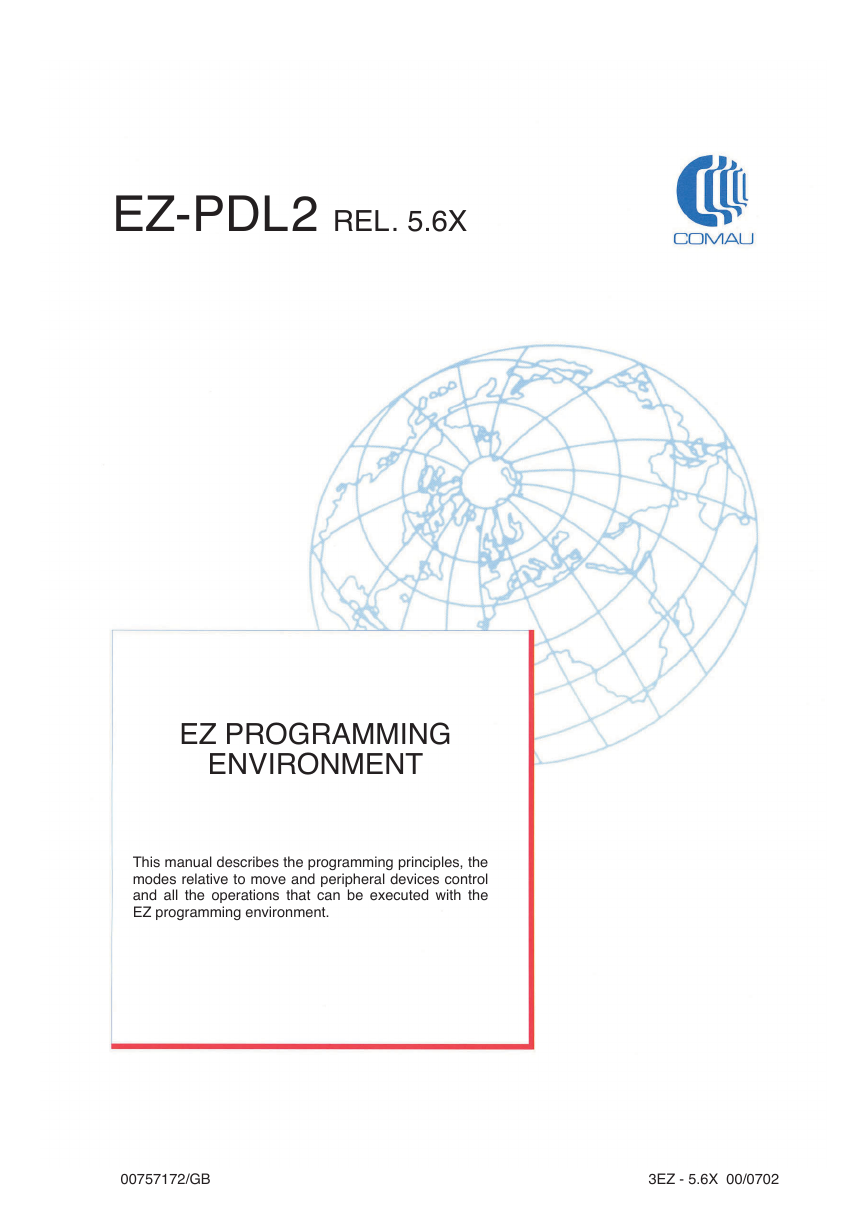
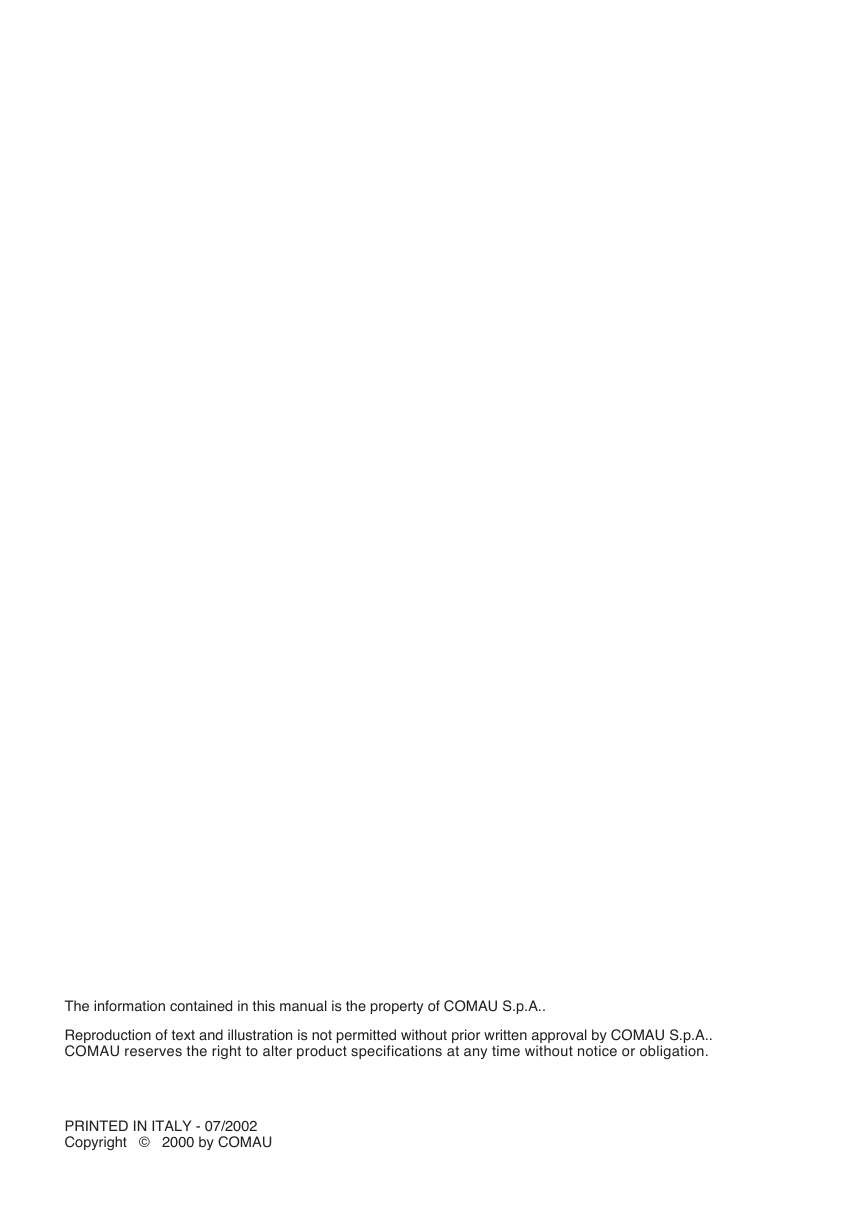

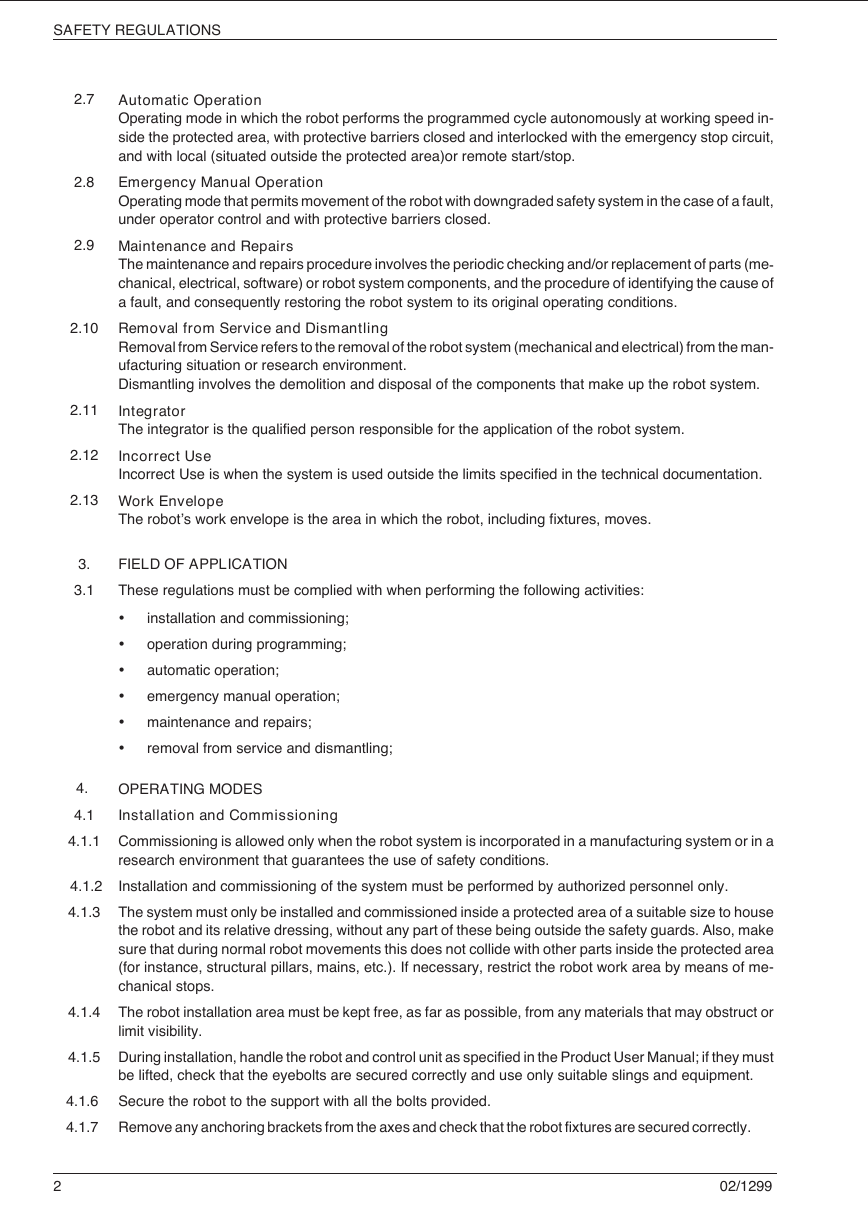
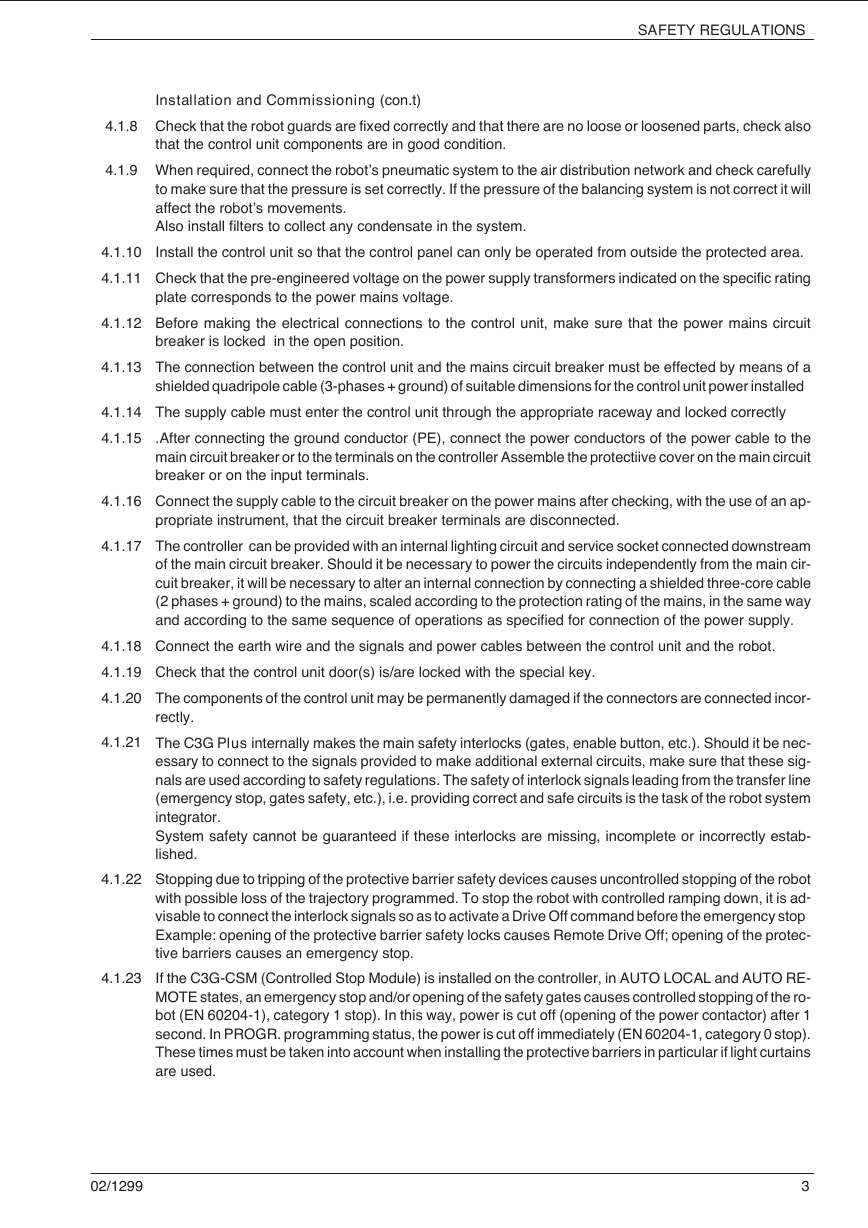
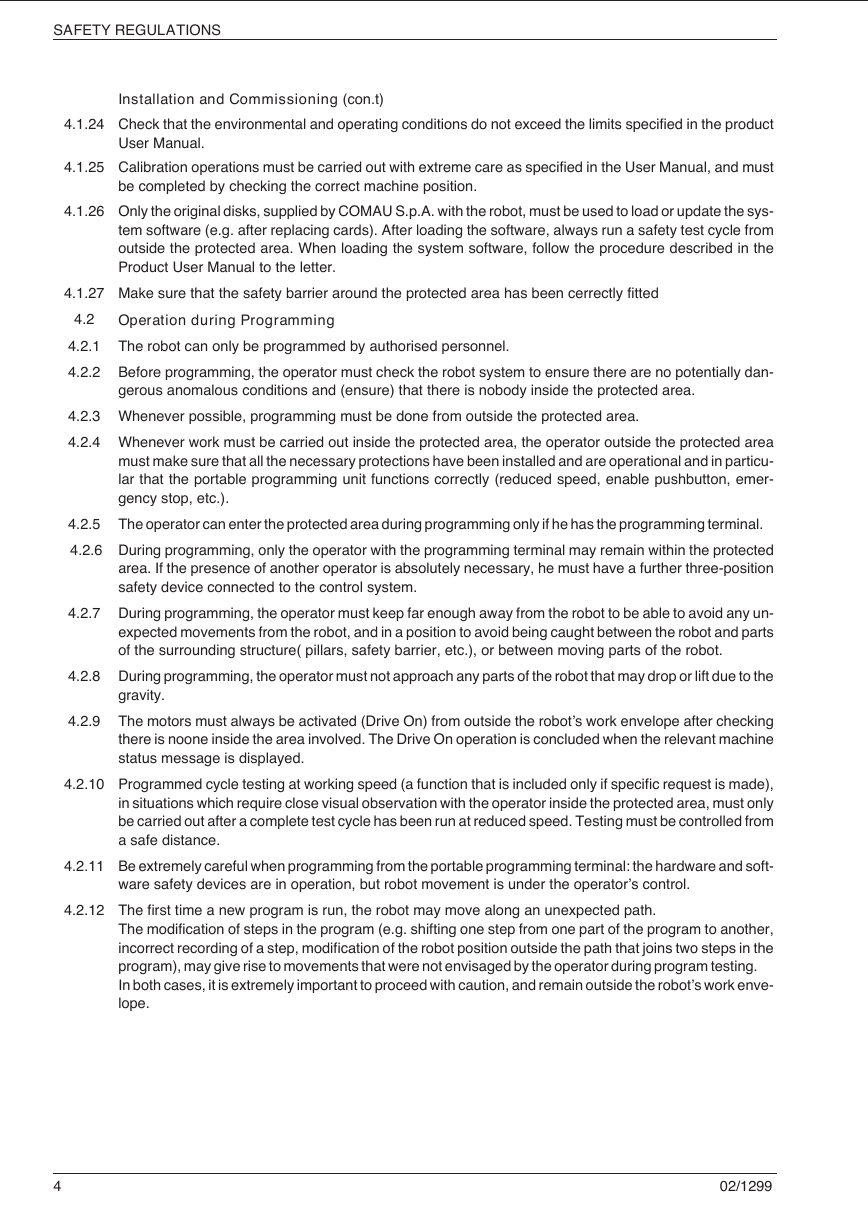
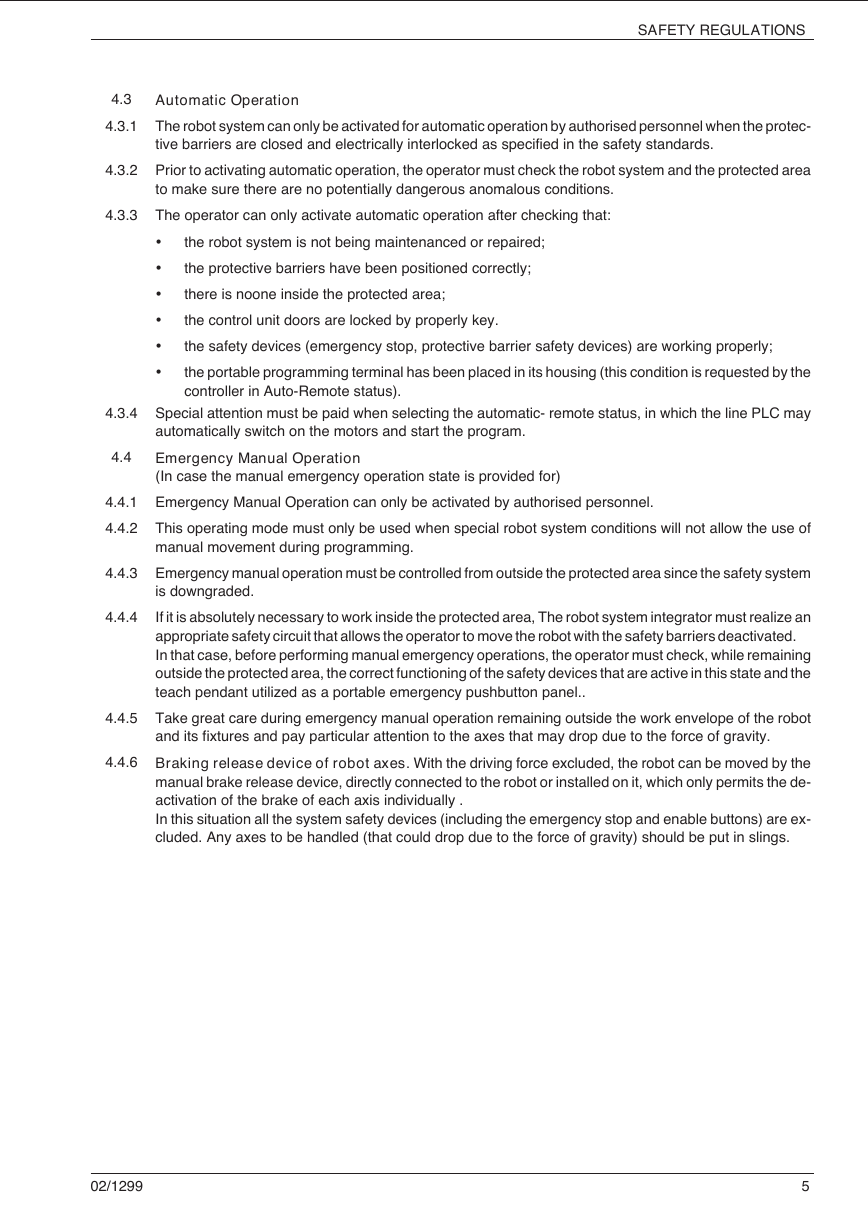









 2023年江西萍乡中考道德与法治真题及答案.doc
2023年江西萍乡中考道德与法治真题及答案.doc 2012年重庆南川中考生物真题及答案.doc
2012年重庆南川中考生物真题及答案.doc 2013年江西师范大学地理学综合及文艺理论基础考研真题.doc
2013年江西师范大学地理学综合及文艺理论基础考研真题.doc 2020年四川甘孜小升初语文真题及答案I卷.doc
2020年四川甘孜小升初语文真题及答案I卷.doc 2020年注册岩土工程师专业基础考试真题及答案.doc
2020年注册岩土工程师专业基础考试真题及答案.doc 2023-2024学年福建省厦门市九年级上学期数学月考试题及答案.doc
2023-2024学年福建省厦门市九年级上学期数学月考试题及答案.doc 2021-2022学年辽宁省沈阳市大东区九年级上学期语文期末试题及答案.doc
2021-2022学年辽宁省沈阳市大东区九年级上学期语文期末试题及答案.doc 2022-2023学年北京东城区初三第一学期物理期末试卷及答案.doc
2022-2023学年北京东城区初三第一学期物理期末试卷及答案.doc 2018上半年江西教师资格初中地理学科知识与教学能力真题及答案.doc
2018上半年江西教师资格初中地理学科知识与教学能力真题及答案.doc 2012年河北国家公务员申论考试真题及答案-省级.doc
2012年河北国家公务员申论考试真题及答案-省级.doc 2020-2021学年江苏省扬州市江都区邵樊片九年级上学期数学第一次质量检测试题及答案.doc
2020-2021学年江苏省扬州市江都区邵樊片九年级上学期数学第一次质量检测试题及答案.doc 2022下半年黑龙江教师资格证中学综合素质真题及答案.doc
2022下半年黑龙江教师资格证中学综合素质真题及答案.doc